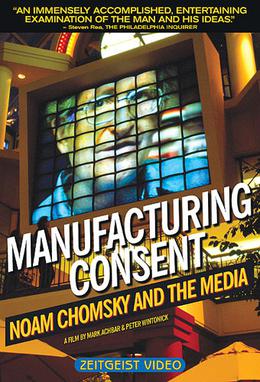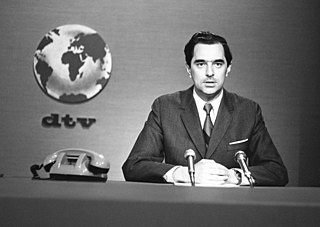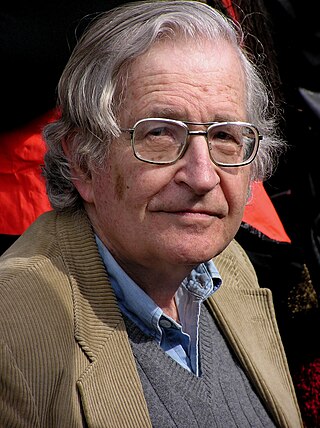Doublespeak is language that deliberately obscures, disguises, distorts, or reverses the meaning of words. Doublespeak may take the form of euphemisms, in which case it is primarily meant to make the truth sound more palatable. It may also refer to intentional ambiguity in language or to actual inversions of meaning. In such cases, doublespeak disguises the nature of the truth.

Manufacturing Consent: Noam Chomsky and the Media is a 1992 documentary film that explores the political life and ideas of linguist, intellectual, and political activist Noam Chomsky. Canadian filmmakers Mark Achbar and Peter Wintonick expand the analysis of political economy and mass media presented in Manufacturing Consent, a 1988 book Chomsky wrote with Edward S. Herman.

Media manipulation refers to orchestrated campaigns in which actors exploit the distinctive features of broadcasting mass communications or digital media platforms to mislead, misinform, or create a narrative that advance their interests and agendas.

The propaganda model is a conceptual model in political economy advanced by Edward S. Herman and Noam Chomsky to explain how propaganda and systemic biases function in corporate mass media. The model seeks to explain how populations are manipulated and how consent for economic, social, and political policies, both foreign and domestic, is "manufactured" in the public mind due to this propaganda. The theory posits that the way in which corporate media is structured creates an inherent conflict of interest and therefore acts as propaganda for anti-democratic elements.
The following outline is provided as an overview of and topical guide to public relations:

Public Opinion is a book by Walter Lippmann published in 1922. It is a critical assessment of functional democratic government, especially of the irrational and often self-serving social perceptions that influence individual behavior and prevent optimal societal cohesion. The detailed descriptions of the cognitive limitations people face in comprehending their sociopolitical and cultural environments, leading them to apply an evolving catalogue of general stereotypes to a complex reality, rendered Public Opinion a seminal text in the fields of media studies, political science, and social psychology.
Edward Samuel Herman was an American economist, media scholar and social critic. Herman is known for his media criticism, in particular the propaganda model hypothesis he developed with Noam Chomsky, a frequent co-writer. He held an appointment as Professor Emeritus of finance at the Wharton School of Business of the University of Pennsylvania. He also taught at Annenberg School for Communication at the University of Pennsylvania.
Mark Achbar is a Canadian filmmaker, best known for The Corporation (2003), Manufacturing Consent: Noam Chomsky and the Media (1994), and as an Executive Producer on over a dozen feature documentaries.
The NCTE George Orwell Award for Distinguished Contribution to Honesty and Clarity in Public Language is an award given since 1975 by the Public Language Award Committee of the National Council of Teachers of English. It is awarded annually to "writers who have made outstanding contributions to the critical analysis of public discourse."

Noam Chomsky is an intellectual, political activist, and critic of the foreign policy of the United States and other governments. Noam Chomsky describes himself as an anarcho-syndicalist and libertarian socialist, and is considered to be a key intellectual figure within the left wing of politics of the United States.

The Anti-Chomsky Reader is a 2004 anthology book about the linguist and social critic Noam Chomsky edited by Peter Collier and David Horowitz. Its contributors criticize Chomsky's political and linguistic writings, claiming that he cherry-picks facts to fit his theories.
The Center for Media and Public Affairs (CMPA) is a self-described nonpartisan and nonprofit research and educational organization that is affiliated with George Mason University in Fairfax, Virginia. It was founded in 1985 by political scientists Samuel Robert Lichter and his ex-wife Linda Lichter. It published a newsletter called Media Monitor from 1987 to 2010.
Manufacturing Consent: The Political Economy of the Mass Media is a 1988 book by Edward S. Herman and Noam Chomsky.
Counter-Revolutionary Violence: Bloodbaths in Fact & Propaganda is a 1973 book by Noam Chomsky and Edward S. Herman, with a preface by Richard A. Falk. It presented the thesis that the "United States, in attempting to suppress revolutionary movements in underdeveloped countries, had become the leading source of violence against native people".
This is a list of writings published by the American author Noam Chomsky.
Alexander Edward Carey was an Australian social psychologist who analysed corporate propaganda. Carey influenced Noam Chomsky, Edward S. Herman and was called a "second Orwell in his prophesies" by Australian journalist and author John Pilger.
Supportive selling environment is an environment which allows for commodities to appear in attractive light. The term was used by Edward Herman and Noam Chomsky in their analysis of the propaganda model.
This is a bibliography of advertising.

The Political Economy of Human Rights is a 1979 two-volume work by Noam Chomsky and Edward S. Herman. The authors offer a critique of United States foreign policy, particularly in Indochina.
The Political Economy of Communications is a branch of communication studies or media studies which studies the power relations that shape the communication of information from the mass media to its public. PEC analyzes the power relations between the mass media system, information and communications technologies (ICTs) and the wider socioeconomic structure in which these operate, with a focus on understanding the historical and current state of technological developments. PEC has proliferated in the 2000s with the modernization of technology. The advancement of media has created conversation about the effects of colonialism and PEC.







